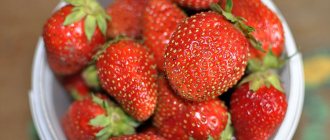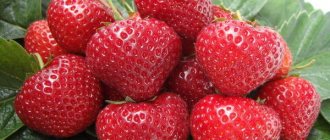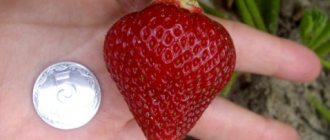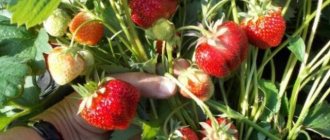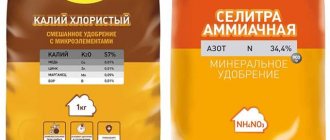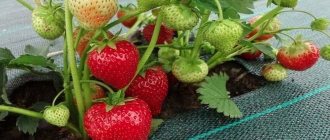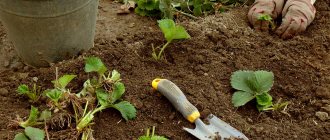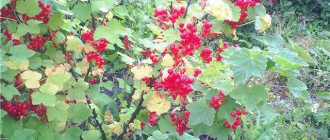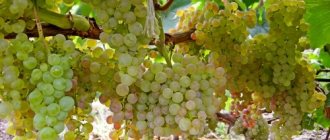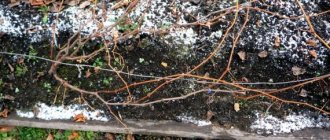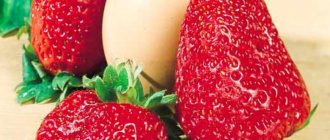Russian gardeners are still little familiar with San Andreas strawberries. The variety is relatively new, but is considered very promising, primarily for commercial production. It is one of the varieties with a remontant type of fruiting, independent of the length of daylight hours.
San Andreas strawberries (pictured) provide high yields due to the remontant type of fruiting
In many respects, the San Andreas strawberry is similar to its “close relatives” - the Albion and Monterey varieties.
Main characteristics
Let's look at the most significant characteristics and features of the variety in the table:
| Parameter | Characteristic |
| Culture | Strawberry (Fragaria ananassa) |
| Ripening period | Mid-early or mid-season |
| Fruiting | Remontantnoe, with 2–4 peaks |
| Photoperiodic type | Neutral daylight hours |
| Productivity | High: on average 0.7-1.0 kg per bush in open ground |
| Mass of berries | In the main collection 25-30 g, maximum - up to 45-50 g |
| Fruit shape | Regular conical or biconical (with rounded top) |
| Berry color | Bright red with a glossy sheen |
| Pulp | Red, juicy, very dense, without voids |
| Tasting assessment | 4.3-4.5 (out of 5) |
| Purpose | Universal |
| Flowers | Large, bisexual, white, with overlapping petals |
| Educational ability | Low |
| Sustainability | The variety is winter-hardy, relatively resistant to drought, spring and autumn frosts. Moderately susceptible to diseases and pests |
| Productive life cycle | Commercial cultivation is recommended for 1-2-year-old crops, amateur cultivation for 3-4-year-old crops. |
| Inclusion in the State Register of the Russian Federation | Turned off |
| Year of registration in the State Register of Belarus | 2014 |
| Originator | The Regents of the university of California (USA) |
Strawberry San Andreas: growing features, planting and care
It's no secret that if you follow agrotechnical cultivation rules, you can significantly increase the yield of a strawberry plantation.
Remontant strawberry cultivation. Features of care - video
Landing
It is better to plant these strawberries in sandy or loamy soils where moisture does not stagnate. The soil should be loose, fertile, with neutral acidity, and the area should be well lit by sunlight.
Photo of planting strawberries
The distance between seedlings in rows should be about 0.3 m, and the row spacing should be about 0.6-0.8 m. The strip method of planting strawberries is also common, in which two rows of strawberries are planted in a bed with a distance between bushes of 0. 3 m, and between lines also 0.3 m. And between adjacent ridges you need to retreat 0.65-0.7 m.
BERRY:
Honeysuckle Nymph Blueberry Elizabeth
Origin and official registration
Strawberries "San Andreas" were bred in the early 2000s by specialists from the University of California (USA). Selection was carried out on the basis of varieties belonging to the Albion line and subspecies Cal 97.86-1. The resulting hybrid is considered one of the improved versions of its famous predecessor. The variety is registered as a trademark, certified in the USA and Canada in 2009, and is actively promoted in the European berry market.
In commercial production in heated greenhouses, crops are obtained almost all year round
The variety is officially approved for cultivation throughout Belarus (included in the State Register in 2014). It is not registered in Russia and Ukraine, but is already quite widely cultivated (especially in the southern regions), showing stable productivity in open and protected ground. In the middle zone, the results are not so impressive, but gardeners note the winter hardiness of the variety (up to −16 ℃), its relative resistance to spring/autumn frosts and droughts, undemandingness to soil types, and high marketable and consumer qualities of the fruit.
Advantages and disadvantages of the variety
The advantages include the following characteristics:
- high immunity of the crop, increased resistance to attack by powdery mildew, anthracnose, blight and late blight;
- possibility of cultivation for commercial purposes;
- high resistance of the root system to drought;
- suitability of berries for long-term transportation and storage;
- high yield - one bush produces up to 1 kg of fruit;
- extended fruiting period - 3-4 peaks are observed during the summer.
“San Andreas” has noticeable shortcomings , the presence of which is confirmed by reviews from gardeners:
- Strawberry bushes are able to grow and actively bear fruit only during the first 3 years of their life, then they must be replaced with new ones. Otherwise, productivity and taste are lost.
- Strawberries should not be overdried. If there is not enough moisture in the soil, the berries will turn out small and unsweetened.
- Plants do not tolerate extreme heat; in July-August they need additional protection from sunlight.
- The variety is able to grow in the south and central Russia because it is not frost-resistant.
Summer residents also highlight the taste of this fruit variety as a disadvantage. They claim that the berries are not distinguished by their aroma and sweetness.
Fruiting dates
Strawberries "San Andreas" are remontant and belong to the day-neutral category (the formation of fruit buds, flowering and ripening of berries do not depend on the length of daylight hours). In terms of ripening time, it is classified as mid-early or mid-ripening, since the beginning of fruiting occurs at the end of May - the third decade of June in open ground or in the middle - end of April in a covered crop (greenhouses, tunnels, hotbeds).
Fruiting of day-neutral strawberry varieties lasts all season until frost
Young seedlings bloom literally 2-3 months after planting, but experts advise removing the first flower stalks in order to achieve higher yields and berry sizes at the next peak. Further fruiting occurs in waves, cyclically (every 4-6 weeks) and lasts until late autumn (mid-October - early November). In too hot periods, the yield intensity of the crop may decrease, since at temperatures above +25 ℃ the formation of peduncles is inhibited and the pollen becomes sterile; accordingly, fruit set does not occur or they take on a non-standard shape.
Day-neutral strawberry varieties are best suited for growing under controlled indoor conditions. In the heat, plants on open plantations need to be shaded (using a net or planting tall crops between the beds) and provided with regular and abundant watering.
Under favorable weather and climatic conditions, plants have time to bear fruit up to 4 times per season. At the same time, the size and taste of the berries vary somewhat: the first ones are the largest, the second harvest has the most pronounced taste.
Further care
Further care for San Andreas strawberry bushes consists of regular watering, fertilizing, removing weeds and loosening the rows.
Watering should be carried out as the top layer of soil dries. After each watering, you should carefully loosen the surrounding area and remove weeds from the beds and between the rows.
As the tendrils form, the beds should be prepared for the autumn planting of new plants to ensure a good harvest next season.
Top dressing
The bushes of the variety should be fed at least once every 2-2.5 weeks, applying complex mineral fertilizers to the berry garden. You can also fertilize plants with humus or compost, alternating the application of organic matter and mineral fertilizers.
Photo of fertilizing for strawberries
Important!
You cannot apply fresh manure under strawberry bushes - it can burn the delicate root system, and the fruits will be bitter.
Preparing for winter
If winters in the region are not cold, and the temperature does not drop below -15 degrees, then these strawberries do not need to be covered for the winter - just come and throw more snow on the beds.
Photo of covering strawberries with lutrasil
In regions with colder winters, lutrasil or other non-woven fabric should be stretched over the beds to protect the plantings from winter frosts.
Commercial and consumer qualities of berries
The variety is large-fruited (berry weight is about 30 g) and productive (the average yield is 1 kg per bush).
Most ripe berries are of uniform size and regular shape, uniformly colored red
The berries have a regular conical or biconical shape and, when fully ripe, become red (a little lighter than Albion's) and shiny. The seeds are slightly pressed into the pulp, the calyxes are large (the diameter is larger than the base of the berries), they are held firmly, the type of detachment is dry. The pulp is red (with an orange tint), juicy. Reviews about the taste of the fruit are contradictory, but most gardeners rate them as excellent: 4.3-4.5 points out of 5; some consider the pulp too coarse and crunchy.
Thanks to their dense texture, the berries have a universal purpose, are easily transported and stored without losing their presentation.
Strawberries "San Andreas", according to gardeners, retain their shape and texture well during heat treatment and freezing
Fruit harvesting and storage rules
In the summer months, strawberry fruits are collected in the early morning hours or in the evening, when solar activity has already subsided. Berries picked in the heat are worse in taste and quality and spoil faster. When picking in early spring or autumn, on the contrary, it is advisable to pick the berries when the sun's rays heat them, drying the morning dew from the fruit.
Berries are collected in plastic booties (1 and 0.5 kilograms) or small, flat cardboard boxes with a capacity of up to 5 kilograms. In this case, transportability and keeping quality will be maximum. After harvesting, it is advisable to cool the fruits, if possible. This procedure further increases the commercial characteristics of strawberries during subsequent transportation.
Sources:
https://agronomu.com/bok/6613-kak-posadit-i-vyrastit-klubniku-zemlyaniku-sorta-san-andreas.html https://sort-klubnika.ru/sorta/klubnika-sort-san-andreas -krupnye-krasivye-plody-i-horoshaya-urozhajnost https://dachamechty.ru/klubnika/san-andreas.html
Features of the plant, propagation and agricultural technology
The bushes are small in height, medium-leafed, spherical, with a powerful root system. The leaves are light green, slightly convex, with sharp teeth along the edges. Stipules, peduncles and tendrils have anthocyanin coloration (reddish tint). The plant-forming ability is low; during the fruiting process, the bushes throw out only a few tendrils. All the forces of the plant are aimed at the formation of peduncles (10-12 pieces each), the formation of ovaries and the filling of fruits. The inflorescences consist of large white flowers located above the level of the leaves.
Photos from sites offering planting material of the variety
Since it is difficult to obtain your own seedlings, purchased seedlings are most often used to renew plantings. To obtain maximum yields, the variety is recommended to be grown in a 1-2-year culture, like most commercial remontant varieties, and for no more than 4 years in one place in amateur gardening. Plants require standard care: watering, fertilizing, mulching or loosening the soil, treating diseases and pests.
Description of the variety
Bushes
San Andreas forms neat compact bushes, reaching a height of 30 cm. The bushes are small but powerful (much more powerful than Albion, including in the power of the root system). The stems are large, the leaves are light green, with serrations. The leafy cap itself is small, but about 10-12 thick flower stalks grow (Albion has 3-4). When the berries ripen, the flowers bend to the ground. This is a normal phenomenon; there are no varieties where the peduncles can support very large fruits. When compared with other varieties, the flower stalks of San Andreas are powerful and some of the berries do not touch the ground, for example, the same Selva ends up completely on the ground.
Berries
The fruits of the San Andreas variety are large, some specimens reach a weight of 70 g. Gardeners post photos on the Internet where they compare the fruits with a chicken egg, but such results can only be achieved with proper care.
The berry has a hard consistency, which suggests good transportability of the fruit. The berries have the shape of an elongated blunt cone, expanding towards the stalk. The skin is shiny, dense, bright red. Seeds depressed. The taste is pleasant, sweet, with a piquant sourness. If we compare again with Albion, then San Andreas berries are more sour.
After the berries are completely reddened, they need to be kept on the bushes for another 2-3 days. Only such San Andreas fruits will be sweet and aromatic.
Productivity
The San Andreas variety bears fruit normally in reduced daylight hours. It begins to bloom in early May, and you can enjoy the first fruits at the end of the month. The early ripening crop continues to produce waves of harvest until the end of October. In total, more than 1.0 kg can be collected in a season. berries from each plant. During the hot period, the return is somewhat reduced, so in the southern regions it is recommended to shade the bushes with nets or awnings.
a brief description of
Advantages of the variety
San Andreas is considered an improved variety of one of its “parents” - the Albion strawberry. Breeders tried their best and developed a culture with numerous advantages:
- very large berries;
- decent yield;
- good taste;
- when frozen, the berries retain their nutritional taste and integrity;
- compact bushes;
- super early ripening;
- long fruiting period;
- disease resistance;
- good resistance to rotting in wet weather;
- transportability and long-lasting shelf life;
- berries are not baked in the sun;
- frost resistance (significantly higher than, for example, Monterey and Portola);
- average demands on soil composition.
- resistance to spotting and mites.
Disadvantages of the variety
The disadvantages are more related to plant care and gardener preferences:
- the presence of sourness in the fruits (if you are looking for a sweet berry in any weather, pay attention to the Charlotte variety);
- sensitivity to humidity levels;
- in hot summers you need to shade the beds;
- a small number of mustaches.
Endurance and ease of care clearly outweigh the presented disadvantages of the variety.
Reviews
Egor, 50 years old, Kharkov
We ordered San Andreas strawberry seedlings from England 2 years ago. During this time, we never liked the variety. It clearly loses to Albion: the berries are not as beautiful (often uneven, strangely shaped) and less tasty. Productivity also raises questions.
Zoya, 47 years old, Grodno region.
My first impressions of the variety are positive. The bushes are strong, quite resistant to spotting and powdery mildew. The berries are dense, sweet, good in any form. Fruit rot is rare on them. There are few whiskers, so there may not be enough stepsons for reproduction, but there is no need to constantly cut them off. Planted more compactly than other varieties. The seedlings take root quickly, young bushes bloom within 2-3 months. Our beds are mulched with straw and drip irrigation is carried out, so no special labor costs are required. I hope he survives the winter safely.
Emil, 34 years old, Dzhankoy district
For the third year now, I have been planting San Andres strawberries in double-row beds in a checkerboard pattern, so that there is 20-25 cm between the bushes, and up to 40 cm between the rows. I like the quality of the berries, but for some reason the bushes begin to fall out at the peak of fruiting. You have to leave all the tendrils and plant out every rosette to preserve the variety.
Diseases and pests, methods of control and prevention
Strawberries are liked not only by people, but also by many insects and birds. And if you can protect crops from birds with a net, they are protected from insects by spraying with insecticides or using organic methods of control. Check your plants once a week to spot any aphids or slugs.
Main pests:
- The weevil is a small, bronze-colored beetle. Damages strawberry buds, which leads to their falling off. One beetle is enough to destroy 50 ovaries. To combat it, the drug “Namabakt” or “Intra-vir” is used at the time of flowering.
- The strawberry leaf beetle is a beautiful beetle with a round shape and dark chestnut color. It attacks the leaves, leaving many small holes and deformed edges of the leaf blade. To destroy the beetle, use “Karbofos” and “Metafos”.
- The larvae of the May beetle (chafers) damage the underground part of the plant. Use Aktaru, Zolon or Bazudin to destroy.
- The strawberry mite damages the leaves, causing them to wrinkle and wilt. For treatment, spraying with a solution of colloidal sulfur is used.
- Aphids are a widespread pest of gardens and vegetable gardens. These are small insects that damage leaves and leave a sticky coating on them. Spraying crops with a solution of insecticidal soap is used against aphids.
- Thrips are small brown or black insects with small wings. The result of their activity is damage to the leaf blade of the leaf, followed by wilting and falling. To destroy them, you can also spray with a solution of insecticidal soap.
- Slugs appear when the air temperature drops and humidity is high. They damage both leaves and berries. The measures taken to combat them are very varied: farmers sprinkle the rows with broken shells, make ditches with water around the beds, and pour phosphorus-potassium fertilizers into the rows, which slugs cannot tolerate.
The choice of insect control products always depends on what kind of pest you have found. Most often, the choice is made on broad-spectrum drugs that work against many pests at the same time.
Typically, diseases affect strawberries due to non-compliance with the watering regime and excess moisture. The San Andreas variety is declared to be resistant to fungal diseases, so there is no need for intensive use of chemicals.
Read more: treating strawberries from pests and diseases.
